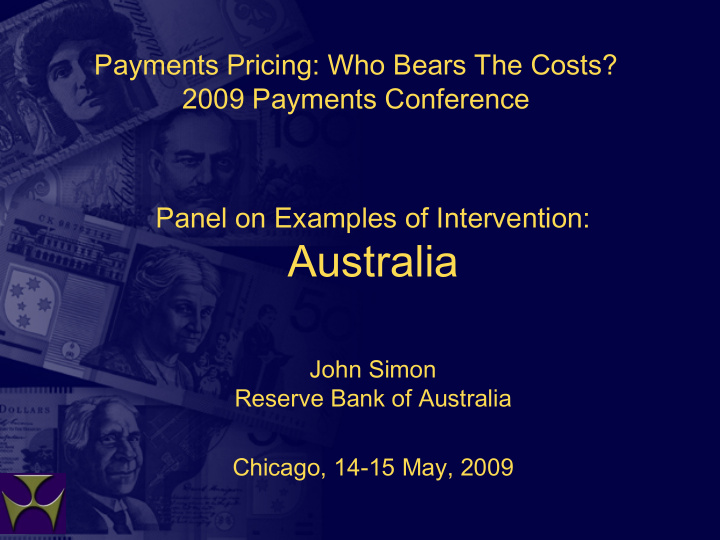



Payments Pricing: Who Bears The Costs? 2009 Payments Conference Panel on Examples of Intervention: Australia John Simon Reserve Bank of Australia Chicago, 14-15 May, 2009
Three questions i. When should public authorities intervene in payment markets? ii. What are the costs and benefits of your regulations on pricing of payment instruments? iii. How do you balance private sector incentives to innovate with regulating payment services to improve consumer and merchant welfare?
Overview 1. Australian Reforms i. When should public authorities intervene in payment markets? ii. What are the costs and benefits of your regulations on pricing of payment instruments? 2. Encouraging Innovation in Australia i. When should public authorities intervene in payment markets? iii. How do you balance private sector incentives to innovate with regulating payment services to improve consumer and merchant welfare?
Australian Reforms When should public authorities intervene? a) When current structure is detrimental � Violates enumerated list of practices (competition law/black letter) � Analysis finds detriments (principles based) b) When things could be better
Australian Reforms • Prohibited no-surcharge rules • Narrowed interchange fee differentials • Increased access • Introduced in 2002 • Review conducted in 2007-08
Australian Reforms • Review conclusions – Reforms have improved social welfare – Price signals are more efficient – No case to relax access improvements or prohibition on no-surcharge rules – Possibility for evolution of regulatory framework exists (See “Reform of Australia’s Payments System: Conclusions of the 2007/08 Review” on the RBA’s website for details)
Australian Reforms • Direct regulation of interchange fees might be replaced with: – Enhanced competition from domestic debit – Further changes to honour all cards – Greater transparency on fees or – Commitment from schemes to cap IFs – Enhanced competition from domestic debit – Greater transparency on fees
Australian Reforms • Objective remains the same, alternative means are being considered • The Bank has not concluded that its reforms were a failure and is not reversing course (despite what you may have heard)
Encouraging Innovation • Many payment systems in Australia are bilaterally-based – No overarching governance structure – Change usually requires unanimity – History of no change – Web of connections makes technical and business relationships complicated ⇒ Innovation impeded
INDUE CITI Independent Deployers Customers BEND LTD NAB STG BQL SUN - First MET Data HSBC CBA ING ANZ many credit Cashcard BOC unions WPAC ADEL BWA EFTEX MAC Pulse Cashconnect Independent ME Deployers Independent many Deployers building societies
Encouraging Innovation • Payment systems require co-operation to work — a network industry • Network industries face co-ordination problems — competitive forces may lead to sub-optimal co-operation • Role for a co-ordinating body is indicated, could be public or private
Encouraging Innovation • No individual participant has the incentive or ability to reform the structure • Reserve Bank actively considering how it might encourage structural change to: – Increase access – Increase competition – Increase innovation
Encouraging Innovation Three approaches: 1. Negotiate voluntary targets 2. Industry solution with threat of regulation 3. Explicit regulation • Technical standards • Outcomes
Encouraging Innovation • Objectives are always the same: competition, efficiency, safety • Behaviour of regulator is dependent upon behaviour of industry • Stay tuned
Recommend
More recommend